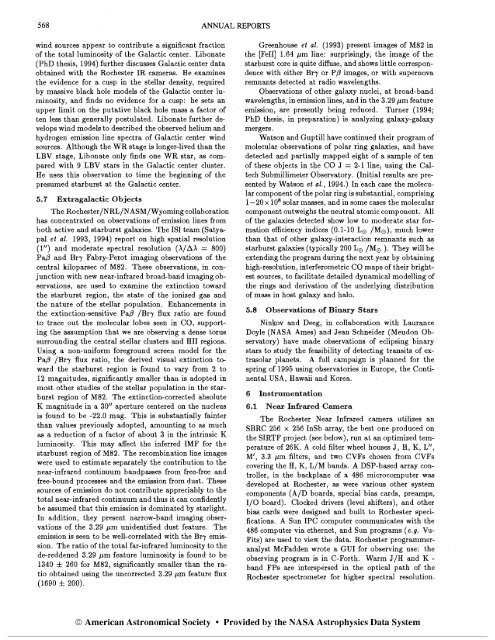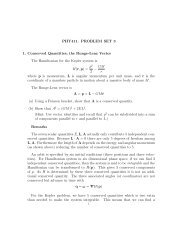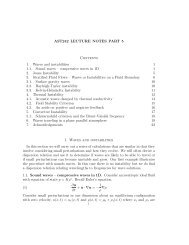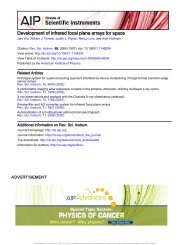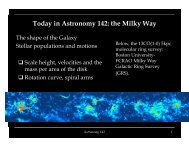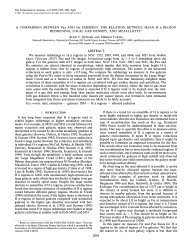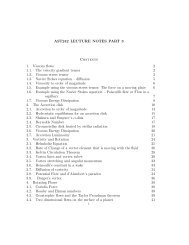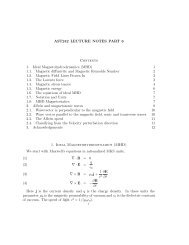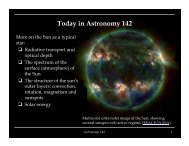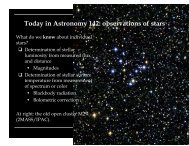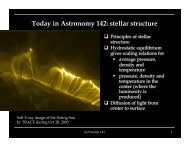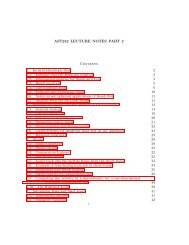University of Rochester C. E. K. Mees Observatory - Astro Pas ...
University of Rochester C. E. K. Mees Observatory - Astro Pas ...
University of Rochester C. E. K. Mees Observatory - Astro Pas ...
Create successful ePaper yourself
Turn your PDF publications into a flip-book with our unique Google optimized e-Paper software.
ANNUAL REPORTSwind sources appear to contribute a significant fraction<strong>of</strong> the total luminosity <strong>of</strong> the Galactic center. Libonate(PhD thesis, 1994) further discusses Galactic center dataobtained with the <strong>Rochester</strong> IR cameras. He examinesthe evidence for a cusp in the stellar density, requiredby massive black hole models <strong>of</strong> the Galactic center luminosity,and finds no evidence for a cusp: he sets anupper limit on the putative black hole mass a factor <strong>of</strong>ten less than generally postulated. Libonate further developswind models to described the observed helium andhydrogen emission line spectra <strong>of</strong> Galactic center windsources. Although the WR stage is longer-lived than theLBV stage, Libonate only finds one WR star, as comparedwith 9 LBV stars in the Galactic center cluster.He uses this observation to time the beginning <strong>of</strong> thepresumed starburst at the Galactic center.5.7 Extragalactic ObjectsThe <strong>Rochester</strong>/NRL/NASM/Wyoming collaborationhas concentrated on observations <strong>of</strong> emission lines fromboth active and starburst galaxies. The IS1 team (Satyapalet al. 1993, 1994) report on high spatial resolution(1") and moderate spectral resolution (X/AX = 800)Pap and Bry Fabry-Perot imaging observations <strong>of</strong> thecentral kiloparsec <strong>of</strong> M82. These observations, in conjunctionwith new near-infrared broad-band imaging observations,are used to examine the extinction towardthe starburst region, the state <strong>of</strong> the ionized gas andthe nature <strong>of</strong> the stellar population. Enhancements inthe extinction-sensitive Pap /Bry flux ratio are foundto trace out the molecular lobes seen in CO, supportingthe assumption that we are observing a dense torussurrounding the central stellar clusters and HI1 regions.Using a non-uniform foreground screen model for thePap /Bry flux ratio, the derived visual extinction towardthe starburst region is found to vary from 2 to12 magnitudes, significantly smaller than is adopted inmost other studies <strong>of</strong> the stellar population in the starburstregion <strong>of</strong> M82. The extinction-corrected absoluteK magnitude in a 30/' aperture centered on the nucleusis found to be -22.0 mag. This is substantially fainterthan values previously adopted, amounting to as muchas a reduction <strong>of</strong> a factor <strong>of</strong> about 3 in the intrinsic Kluminosity. This may affect the inferred IMF for thestarburst region <strong>of</strong> M82. The recombination line imageswere used to estimate separately the contribution to thenear-infrared continuum bandpasses from free-free andfree-bound processes and the emission from dust. Thesesources <strong>of</strong> emission do not contribute appreciably to thetotal near-infrared continuum and thus it can confidentlybe assumed that this emission is dominated by starlight.In addition, they present narrow-band imaging observations<strong>of</strong> the 3.29 pm unidentified dust feature. Theemission is seen to be well-correlated with the Bry emission.The ratio <strong>of</strong> the total far-infrared luminosity to thede-reddened 3.29 pm feature luminosity is found to be1340 f 260 for M82, significantly smaller than the ratioobtained using the uncorrected 3.29 pm feature flux(1690 f 200).Greenhouse et al. (1993) present images <strong>of</strong> M82 inthe [FeII] 1.64 pm line: surprisingly, the image <strong>of</strong> thestarburst core is quite diffuse, and shows little correspondencewith either Bry or PP images, or with supernovaremnants detected at radio wavelengths.Observations <strong>of</strong> other galaxy nuclei, at broad-bandwavelengths, in emission lines, and in the 3.29 pm featureemission, are presently being reduced. Turner (1994;PhD thesis, in preparation) is analyzing galaxy-galaxymergers.Watson and Guptill have continued their program <strong>of</strong>molecular observations <strong>of</strong> polar ring galaxies, and havedetected and partially mapped eight <strong>of</strong> a sample <strong>of</strong> ten<strong>of</strong> these objects in the CO J = 2-1 line, using the CaltechSubmillimeter <strong>Observatory</strong>. (Initial results are presentedby Watson et al., 1994.) In each case the molecularcomponent <strong>of</strong> the polar ring is substantial, comprising1-20 x 10' solar masses, and in some cases the molecularcomponent outweighs the neutral atomic component. All<strong>of</strong> the galaxies detected show low to moderate star formationefficiency indices (0.1-10 La /Ma), much lowerthan that <strong>of</strong> other galaxy-interaction remnants such asstarburst galaxies (typically 200 La /Ma ). They will beextending the program during the next year by obtaininghigh-resolution, interferometric CO maps <strong>of</strong> their brightestsources, to facilitate detailed dynamical modelling <strong>of</strong>the rings and derivation <strong>of</strong> the underlying distribution<strong>of</strong> mass in host galaxy and halo.5.8 Observations <strong>of</strong> Binary StarsNinkov and Deeg, in collaboration with LauranceDoyle (NASA Ames) and Jean Schneider (Meudon <strong>Observatory</strong>)have made observations <strong>of</strong> eclipsing binarystars to study the feasibility <strong>of</strong> detecting transits <strong>of</strong> extrasolarplanets. A full campaign is planned for thespring <strong>of</strong> 1995 using observatories in Europe, the ContinentalUSA, Hawaii and Korea.6 Instrumentation6.1 Near Infrared CameraThe <strong>Rochester</strong> Near Infrared camera utilizes anSBRC 256 x 256 InSb array, the best one produced onthe SIRTF project (see below), run at an optimized temperature<strong>of</strong> 26K. A cold filter wheel houses J, H, K, L",Mi, 3.3 pm filters, and two CVFs chosen from CVFscovering the H, K, L/M bands. A DSP-based array controller,in the backplane <strong>of</strong> a 486 microcomputer wasdeveloped at <strong>Rochester</strong>, as were various other systemcomponents (AID boards, special bias cards, preamps,110 board). Clocked drivers (level shifters), and otherbias cards were designed and built to <strong>Rochester</strong> specifications.A Sun IPC computer communicates with the486 computer via ethernet, and Sun programs (e.g. Vu-Fits) are used to view the data. <strong>Rochester</strong> programmeranalystMcFadden wrote a GUI for observing use: theobserving program is in C-Forth. Warm J/H and K -band FPs are interspersed in the optical path <strong>of</strong> the<strong>Rochester</strong> spectrometer for higher spectral resolution.O American <strong>Astro</strong>nomical SocietyProvided by the NASA <strong>Astro</strong>physics Data System


